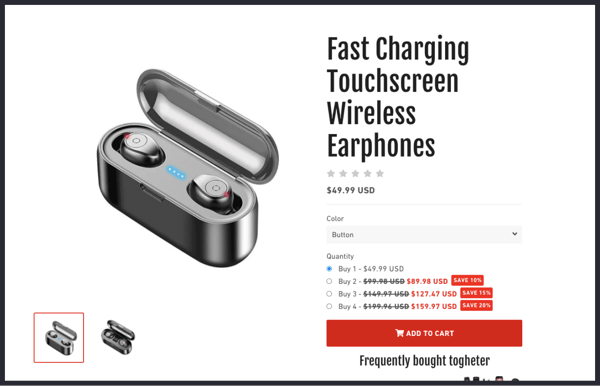Is Deep Discounting Bad for eCommerce Brand Trust?

Table of Contents
Amazon's 92% deep discount on air fryers recently sent British shoppers running amok on social media. The deal, which offered bargain hunters a $60 air fryer for the unbelievable price of $5.47, opened the doors to a new wave of what-a-scam memes.
Amazon explained the incident away as a 'glitch' in the system. However, skeptic shoppers argued that the whole promotion was a clever scam designed to mine shoppers' data - a claim refuted by That's Nonsense, an independent online safety body.
If Amazon's pervasive reputation hasn't been spared the distrust associated with deep discounting, can smaller eCommerce brands successfully look towards deep discounting as a reliable sales strategy without compromising brand trust?
But first, why do eCommerce brands offer deep discounts?
"I just want to sell huge volumes - whether I lose money or not..." said no smart seller ever. So what leads eCommerce brands to keep considering deep-discounting as a viable sales strategy?
While deep discounting might sound like the no-brainer ticket to ramp up sales volume, the actual outcome could leave brands in a worse situation than before.
The most obvious reason is that it sounds like a great customer acquisition strategy - get them through the door, then sell them more stuff.

But does this strategy fit all store sizes and niches? Perhaps within a competitive 1970s setting, brick-and-mortar retailers like JCPenney might have found this a suitable expansion strategy.
However, for eCommerce brands operating in a post-pandemic era, the results might differ. Say, if the 92% off air fryer discount discussed above were to be offered by a smaller eCommerce brand, would upsell of complementary products - vegetable cutters, chopping boards, etc. be sufficient to make up for the guaranteed loss likely to be incurred by the main offer?
Unlikely.
Another driver for deep discounting might be undercutting the competition. Suppose the goal is to offer the most competitively priced products in the industry. In that case, eCommerce brands could find themselves digging deeper and deeper into their margins to divert customers away from the competition.
Evidence has shown that using price as a competitive weapon leaves no long-term industry winners. Like real wars, price wars tend to take a toll on their combatants, resulting in overall diminished industry profitability.
For eCommerce brands looking for long-term growth, this sounds like a counterproductive lasting growth strategy. Ecommerce brands need a growth strategy built on trust, loyalty, transparency and the provision of value - not deep-discounting.
How does deep-discounting affect customer behavior?
From a customer's perspective, discounts are attractive. The bigger they are, the more alluring they become. The scarcity and limited availability of deals can create a sense of urgency that compels customers to buy without much hesitation. But what happens in the customer's head long after the purchase?
While volume sales from deep discounts might appear as a quick win, the accurate measurement of winning lies in the impression the customer is left with after the purchase is made.
In a study of apparel products, researchers found that the higher the discount, the lower the customer's perception of product quality. In other words, rock bottom prices led to rock bottom perceptions of brand quality.
The problem here isn't the perception of the acquisition of a single low-quality product. Instead, the problem here lies in the extension of this negative perception across the entire brand.
Deep-discounting trains your customers to devalue your products.
With this conditioning in place, the expectation is created in the customer's mind to expect products and services of lower quality and at a lower price point. With these expectations set, you create psychological barriers to customers making regular-priced purchases from your brand.
What effect does deep discounting have on brand value?
When evaluating the effect of deep discounting on brands, no poster child demonstrates this better than Groupon - the discounts and deals marketplace. Valued at $1.35 billion in 2010, Groupon successfully attracted shoppers in their droves with discounts of up to 80% across a huge variety of products and business types.
The strategy seemed to work well because in the months following; the startup grew fast enough to attract (and turn down) a $5B acquisition offer from Google.
Fast forward to 2021, Groupon is worth half of its 2010 value ($0.67B) and is diversifying its core strategy away from deep discounting and towards strategic, lighter discounts that encourage habitual use.
Groupon's 'perfect' deep-discount model makes a few truths evident. First, it attracts a specific type of customer - price-sensitive customers who are not interested in brand loyalty.
These customers offer little or no lifetime value to Commerce brands relying on deep-discounting as a customer acquisition strategy. Because of the low chances of these customers returning, it is easy to see that they are not the target audience of any long-term growth-seeking eCommerce brand.
Brands acquiring these customers through deep-discount sites like Groupon should expect their loyalty to lie with the discount sites rather than with them.
If Groupon itself couldn't pull off a deep discounting strategy indefinitely, eCommerce brands stand less of a chance of succeeding down the same path. Groupon's shares decline shows that deep discounting is not a sustainable sales strategy.
Deep discounting promises a flood of customers and increased revenue, but the reality points to brand devaluation and reduced or non-existent profit margins.
As important as it is to remain competitive and offer value to your customers, there is also a need to consider your ideal target customer in terms of maximum lifetime value rather than quick wins.
How to use discounts to increase the customer lifetime value
Now understanding what cannot be achieved deep discounting, how can eCommerce brands strategically use discounts to attract customers, remain competitive and increase customer lifetime value? Here are a few tips:
Begin with your end goal in mind
Consider what you are trying to achieve with your discount, as offering purposeless discounts is a sure-fire way to hurt your brand.
- Are you trying to sell off old stock?
- Do you want to attract customers to a new product category?
- Or perhaps you are looking to boost your sales during off-peak seasons?
The clearer you are about your goals, the better chances of success you have.
Crunch key numbers
While deep discounting may increase your sales volume, the same might not be true for your profit margins (a.k.a, the lifeblood of your business).
Anticipate the effects of your planned discounting exercise by crunching your key numbers - your intended discounted price, cost of goods, overheads and sales volume.
By crunching the numbers before launching your proposed discount offer, you have an idea of what to expect and when to pull the plug if need be.
Run simple A/B tests
It's never easy to predict which offers are likely to flop and which ones are likely to fly.
For this reason, sensible marketers run simple A/B tests which essentially show variations of the same message to similar customer groups. By doing this, you can then make data-driven decisions and better understand what type of offers your customers are most likely to respond to.
Segment and target your offers
In today's world, one-size-fits-all is no longer an effective marketing strategy. With the availability of richer customer data, it is now possible to refine your offers and make them relevant to your target customers.
For example, offering discounts on beard oil in a group for new moms or sending a mattress offer to people who bought mattresses from you in the last week might not be the best use of your air time.
So when discounting, it's important to be intentional about sending the most personalized offers to the right customers also remembering to stay within the legal confines of evolving privacy laws.
Measure your performance
Following your discount promotion, it is always a good idea to evaluate your performance to see how well (or how badly) you did.
- How well did the offer convert?
- Were there spikes in purchases of any particular product?
- Were there products that failed to interest your customers enough to buy?
- Did you achieve any of your set goals, and by how much? If not, why not?
- By understanding your performance, you are better equipped to make data-driven decisions in the future.
For eCommerce brands, deep discounting is a dangerous strategy to rely entirely upon, especially in the long term. Discounts are best combined with strategic intent, such as saying thank you for existing customers or as a one-off welcome offer for new customers.
Pricing plays a key role in setting customer expectations and perceived value, and deep discounting techniques only reduce brand value in the long term.
When applied strategically as part of a larger objective to achieve set goals and targets, discounts can add value to the brand rather than devaluing it.
Ada Powers